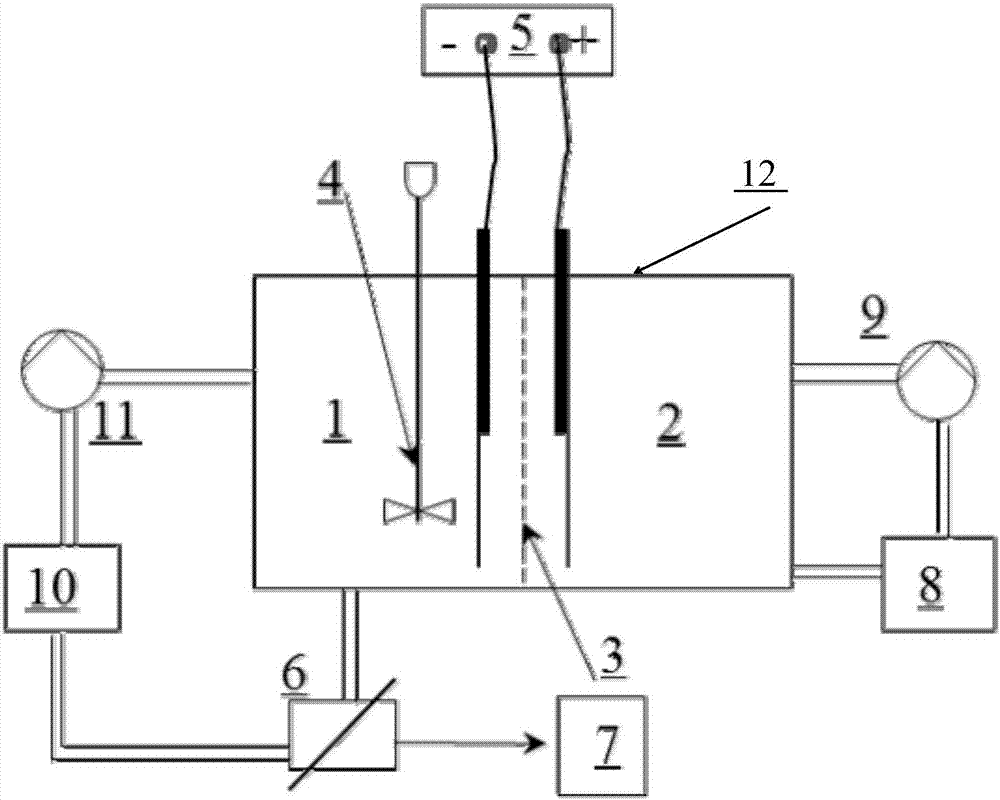Method for preparing aluminum oxide by electrolyzing aluminum chloride
A technology of aluminum chloride and alumina, applied in the field of electrolysis, can solve the problems of high cost, high energy consumption, large pollution, etc., and achieve the effects of short process flow, high purity and lower production cost
- Summary
- Abstract
- Description
- Claims
- Application Information
AI Technical Summary
Problems solved by technology
Method used
Image
Examples
Embodiment 1
[0044] In this embodiment, the method for electroconverting aluminum chloride into alumina is carried out in the following steps:
[0045] Step 1: electrolyze the aluminum chloride aqueous solution, the process parameters of the electrolysis are: the temperature is 20°C, and the voltage of the electrolysis is 3V;
[0046] In described step 1, the mass concentration of described aluminum chloride aqueous solution is 50g / L;
[0047] Step 2: Control the electrolytic current density of the cationic membrane electrolyzer to 0.01A / cm 2 , so that aluminum hydroxide is directly generated in the cathode chamber 1 of the cationic membrane electrolyzer;
[0048] Step 3: Stir the cathode chamber 1 of the cationic membrane electrolyzer, the electrolyte and aluminum hydroxide in the cathode chamber 1 flow in a directional manner, filter through the filter device 6, and separate the solid and liquid to obtain aluminum hydroxide and filtrate, and the filtrate is circulated back to the cathod...
Embodiment 2
[0054] Step 1: electrolyzing the aluminum chloride aqueous solution, the process parameters of the electrolysis are as follows: the temperature is 90°C, and the voltage of the electrolysis is 20V;
[0055] In described step 1, the mass concentration of described aluminum chloride aqueous solution is 200g / L;
[0056] Step 2: Control the electrolytic current density of the cationic membrane electrolyzer to 0.6A / cm 2 , so that aluminum hydroxide is directly generated in the cathode chamber 1 of the cationic membrane electrolyzer;
[0057] Step 3: Stir the cathode chamber 1 of the cationic membrane electrolyzer, the electrolyte and aluminum hydroxide in the cathode chamber 1 flow in a directional manner, filter through the filter device 6, and separate the solid and liquid to obtain aluminum hydroxide and filtrate, and the filtrate is circulated back to the cathode Chamber 1 is used as the electrolyte in cathode chamber 1; the solution in anode chamber 2 is continuously extracted...
PUM
| Property | Measurement | Unit |
|---|---|---|
| melting point | aaaaa | aaaaa |
| boiling point | aaaaa | aaaaa |
Abstract
Description
Claims
Application Information
 Login to View More
Login to View More - R&D
- Intellectual Property
- Life Sciences
- Materials
- Tech Scout
- Unparalleled Data Quality
- Higher Quality Content
- 60% Fewer Hallucinations
Browse by: Latest US Patents, China's latest patents, Technical Efficacy Thesaurus, Application Domain, Technology Topic, Popular Technical Reports.
© 2025 PatSnap. All rights reserved.Legal|Privacy policy|Modern Slavery Act Transparency Statement|Sitemap|About US| Contact US: help@patsnap.com

